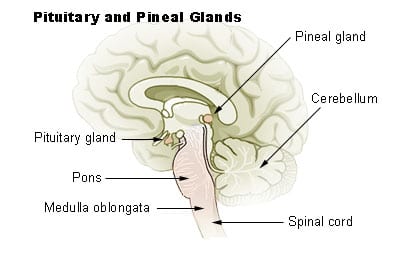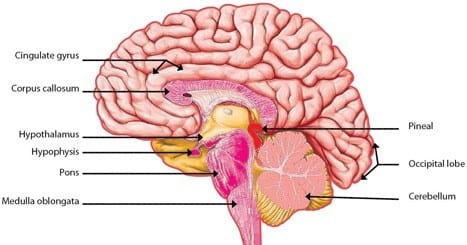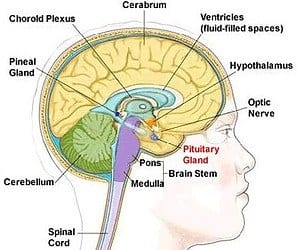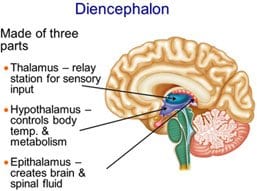The Functions and Importance of The Pineal and Pituitary Glands
Blue indicates link
Two small glands control human development. Sometimes called a management system for your brain functions. Controlling growth, psychological functions, sexual function and so much more. The Pineal gland sometimes referred to as “The Third Eye” is responsible for activating certain functions such as enabling increased psychic awareness and psychic talents. Some people believe that supernatural powers will be initiated with pineal gland activation.

For my purpose and understanding, this was the easiest to read and understand what the “Pineal Gland”, was all about.
The pineal gland is a small, pine cone-shaped gland of the endocrine system. A structure of the diencephalon of the brain, the pineal gland produces the hormone melatonin. Melatonin influences sexual development and sleep-wake cycles. The pineal gland is composed of cells called pinealocytes and cells of the nervous system called glial cells. The pineal gland connects the endocrine system with the nervous system in that it converts nerve signals from the sympathetic system of the peripheral nervous system into hormone signals. Over time, calcium deposits build up in the pineal, and its accumulation can lead to calcification in the elderly.
Function:
The pineal gland is involved in several functions of the body including:
Secretion of the hormone melatonin
Regulation of endocrine functions
Conversion of nervous system signals to endocrine signals
Causes sleepiness
Influences sexual development
Influences immune system function
Antioxidant activity
Location:

Directionally the pineal gland is situated between the cerebral hemispheres and attached to the third ventricle. It is located in the center of the brain.
Pineal Gland and Melatonin:
Melatonin is produced within the pineal gland and synthesized from the neurotransmitter serotonin. It is secreted into the cerebrospinal fluid of the third ventricle and is directed from there into the blood. Upon entering the bloodstream, melatonin can be circulated throughout the body. Melatonin is also produced by other body cells and organs including retinal cells, white blood cells, gonads, and skin.
Melatonin production is vital to the regulation of sleep-wake cycles (circadian rhythm) and its production is determined by light and dark detection. The retina sends signals about light and dark detection to an area of the brain called the hypothalamus. These signals are eventually relayed to the pineal gland. The more light detected, the less melatonin is produced and released into the blood. Melatonin levels are at their highest during the night and this promotes changes in the body that help us to sleep. Low levels of melatonin during daylight hours help us to stay awake.
Melatonin has been used in the treatment of sleep-related disorders including jet lag and shift-work sleep disorder. In both of these cases, a person’s circadian rhythm is disrupted either due to travel across multiple time zones or due to working night shifts or rotating shifts. Melatonin has also been used in the treatment of insomnia and depressive disorder.
Melatonin influences the development of reproductive system structures as well. It inhibits the release of certain reproductive hormones from the pituitary gland that affect male and female reproductive organs. These pituitary hormones, known as gonadotropins, stimulate gonads to release sex hormones. Melatonin, therefore, regulates sexual development. In animals, melatonin plays a role in regulating mating seasons.
Pineal Gland Dysfunction:
Should the pineal gland begin to function abnormally, a number of problems may result. If the pineal gland is not able to produce sufficient amounts of melatonin, a person could experience insomnia, anxiety, low thyroid hormone production (hypothyroidism), menopause symptoms, or intestinal hyperactivity. If the pineal gland produces too much melatonin, a person could experience low blood pressure, abnormal function of the adrenal and thyroid glands, or Seasonal Affective Disorder (SAD). SAD is a depressive disorder that some individuals experience during the winter months when sunlight is minimal.


The Third Eye:
The pineal gland (also called the “third eye”) is a small endocrine gland. It produces melatonin, a hormone that affects the modulation of wake/sleep patterns and photoperiodic (seasonal) functions. It is located near the center of the brain between the two hemispheres, tucked in a groove where the two rounded thalamic bodies join. Unlike much of the rest of the brain, the pineal gland is not isolated from the body by the blood-brain barrier system.
While the physiological function of the pineal gland has been unknown until recent times, mystical traditions and esoteric schools have long known this area in the middle of the brain to be the connecting link between the physical and spiritual worlds. A physical eye that could see beyond space-time.
The Pineal Gland or the ‘third eye’ can be activated to spiritual world frequencies. A pineal gland once tuned into proper frequencies with the help of meditation, yoga, or various esoteric, occult methods, and music, enables a person to travel into other dimensions, popularly known as astral travel astral projection, or remote viewing.
Pineal gland activation will awaken our mind’s ability for prophecy. A person who has achieved pineal gland activation will experience increased psychic awareness and psychic talents. Some people believe that supernatural powers will be initiated with pineal gland activation.
The Third Eye Chakra and The Pineal Gland
What is a Chakra? Please click for more information.
Have you taken a close look at a one-dollar bill? Have you noticed the “all-seeing eye” above the pyramid? It represents the third eye, which is considered the highest and most powerful source of ethereal energy available to man. Egyptians, Indians, and many other groups were and are very aware of this inner power, but somehow we were deprived of this information.
The pineal gland (also known as the pineal body, epiphysis cerebri, epiphysis, or third eye) is a small endocrine gland in the vertebrate brain. It is photo-receptive and located between the two hemispheres, near the center of the brain. The pineal gland also produces a hormone called melatonin, which affects the modulation of wake and sleep patterns.
The third eye chakra is located in between the eyebrows, in the middle of the forehead. With meditation, trust, and direct focus on the third eye, a person can activate his or her pineal gland and access their higher self or higher consciousness, a center of intuition and foresight. Eastern and Western spiritual traditions consider the third eye to be the “inner eye” and Hinduism and Buddhism consider the third eye a symbol of enlightenment.
The “Seeing Eye”. Please click for images and information.

With enough intention and practice, a person is supposed to eventually be able to move freely from the physical world to the spiritual or astral world and back, using the third eye chakra as a gateway. This is also known as astral projection or astral travel. The third eye also controls various bio-rhythms in the body. It has been said that when the eye opens, a person can feel pressure at the base of the brain.
There is a big conversation going on over the idea that those who control our world have been using this power and keeping it for self-gain and the big agenda. In any case, as long as we humans are purely focused on the physical world, we’ll never understand our full potential. It’s time we all take a look inward.
It’s also important to become aware of fluoride. It kills the pineal gland and yet it is found in hundreds of everyday products, like toothpaste, food, and soda. We read Sodium Fluoride is added to 90% of the U.S. water supply, meaning it’s in our tap water too. According to a study by the scientist, Jennifer Luke, the pineal gland absorbs more fluoride than any other physical material in the human body. Fluoride literally dumbs us down and keeps us from being able to access higher realms.
If humans can realize the power within, there is a chance everyone can learn to establish an inner connection and awaken. This world is magical and exciting and it is taken for granted. It just takes letting go of the ego, superficiality, and negativity, so we can see clearly through the veil and make better choices for ourselves, each other, and this world.
Difference Between Pituitary and Pineal Gland | Pituitary …
The pituitary gland is located at the base of the brain and is attached to the hypothalamus by a small stalk, whereas the pineal gland is located on the roof of the third ventricle of the brain. Unlike the pineal gland, the pituitary gland is composed of two parts. The pituitary gland secretes nine hormones while the pineal gland secretes only one hormone.
Pituitary gland:
The pituitary gland is a small pea-sized gland that plays a major role in regulating vital body functions and general wellbeing. It is referred to as the body’s ‘master gland’ because it controls the activity of most other hormone-secreting glands.
What does my pituitary gland do?
The pituitary gland is called the ‘master gland’ as the hormones it produces control so many different processes in the body. It senses the body’s needs and sends signals to different organs and glands throughout the body to regulate their function and maintain an appropriate environment. It secretes a variety of hormones into the bloodstream which acts as messengers to transmit information from the pituitary gland to distant cells, regulating their activity. For example, the pituitary gland produces prolactin, which acts on the breasts to induce milk production.
The pituitary gland also secretes hormones that act on the adrenal glands, thyroid glands, ovaries, and testes, which in turn produce other hormones. Through the secretion of its hormones, the pituitary gland controls metabolism, growth, sexual maturation, reproduction, blood pressure, and many other vital physical functions and processes.
Early Warning Signs of Pituitary Gland Disorders in Adults:
- Loss of peripheral or blurred vision
- Experience menstrual irregularities and sexual dysfunction
- Enlargement of face, fingers, and forehead
- Bruise easily without an injury
- Weakening of muscles
Early Warning Signs of Pituitary Gland Disorders in Children:
- Abnormal growth rate
- Early signs of puberty, girls before 7 and boys before 8 years
- Excessive drinking of water.
The pituitary is critical because, if it is not doing its job, it has the opportunity to really compromise some of the most important systems in your body – it gives them a bit of an opportunity to “goof off.”
Let’s imagine that these aforementioned glands are all workers and that the pituitary is their manager who helps to get them to work. Basically, the manager is instructed by the CEO (your hypothalamus, in this case) to work, which starts a chain reaction of people telling other people to get to work. So, while the CEO might direct the manager to motivate the workers, the manager is the one who has to go out there and do it.
The pituitary gland’s relationship to the rest of the body is known as “positive feedback” – meaning that they only work when they are told, and the pituitary gland is in charge of making sure that they do the work they are told to complete. This is how the whole endocrine system works, essentially.
Thank you for reading,
Michael.
Comments are welcome
Hi, interesting article on the Pineal and Pituitary glands for the purpose of functions of the third eye.. I have to admit I’m a bit confused here. So the chakra is between our eyes and it’s the same thing that is on the pyramid on the back of the US dollar. I’ve always wondered why that eye is there, it’s strange to say the least. I’m wondering if there is any scientific study that has well documented the use of the third eye? Thanks, it’s very interesting indeed.
Hi riverdogg,
Thank you for your comments.
I have looked to see if there is any scientific studies about the third eye. There is no denial or admission into the third eye. I have also wondered why certain cultures in India where that red dot in the middle of their forehead.
I find it kind of fascinating.
Best wishes,
Michael
Hello Michael,
Very interesting to know now the importance of the pineal and pituitary glands. The first also known as the third eye. On this it is believed that certain supernatural powers originate through this gland. Problems of dysfunction can cause different problems that you explain very well.
The pituitary gland secretes a variety of hormones in the bloodstream, regulating its activity.
After reading such an informative article, I have no doubt about its importance.
Thank you!
Hi Claudio,
Thank you for your comments.
It seems you are quite knowledgeable about the pituitary gland. I was quite surprised to learn about the third eye and the certain powers and potential of the supernatural powers involved with this gland.
All the best,
Michael
Hi! I love how informative and great your articles are. Can you recommend any other Spiritual Awakening blogs that go over the same topics? Thanks a lot!
Thank you, Nikita. I will look for some more articles and send you an e-mail when I find something if that is OK with you.
All the best,
Michael
Hi! I love how informative and great your articles are. Can you recommend any other blogs that share blogs that share information on Spiritual Awakening or spirituality in general? Thanks a lot!